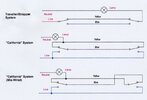"Analyzing" this "Problem" has been an "Interesting" exercise for a Summer Sunday afternoon - in Australia!
I apologize for using "Americanisms", but I am used to having 2-Way circuits in Australia wired as for that which is called in North America a "Traveler System" but it seems that in the UK this is called a "Strapper" System - as shown in the first diagram below.
I suspect that the circuit is wired as what is called in North America as a "California System", which I understand may be fairly "normal" in the UK and shown correctly wired in the Second Diagram below.
(See https://en.wikipedia.org/wiki/Multiway_switching )
What is that System called in the UK?

One advantage of this second (California ?) system is that the Lamp could be connected at either end.
In North America, Energy (often miscalled "Power") could also be derived for a 15 A/120 V Socket Outlet at the "far" end, if a Neutral is also available there !
The second diagram above shows a correctly wired "California" System and
the third diagram shows the same system wired incorrectly - giving the problems encountered by pmartin008 ,
with the Lamp and Supply Line connected at the "Landing" and the "Dimmer" SPDT Switch at the "Ground Floor".
(The "Named" Colors of the wiring insulation is immaterial, except to indicate the possibility of reversal.)

The above two diagrams show the "Complications" introduced by using a "Crossover/Intermediate" switch to do the job of a SPDT switch.
So, reverse the connections of the Blue and Yellow insulated wires at ONE end and it is likely that the problem may be solved !
Why the original "installer" used a (Relatively Expensive) "Intermediate/Crossover" switch,
in lieu of a SPDT switch
(which would have "done the job" for only a 2-Way [2-Location] switching situation)
is incomprehensible!
I apologize for using "Americanisms", but I am used to having 2-Way circuits in Australia wired as for that which is called in North America a "Traveler System" but it seems that in the UK this is called a "Strapper" System - as shown in the first diagram below.
I suspect that the circuit is wired as what is called in North America as a "California System", which I understand may be fairly "normal" in the UK and shown correctly wired in the Second Diagram below.
(See https://en.wikipedia.org/wiki/Multiway_switching )
What is that System called in the UK?

One advantage of this second (California ?) system is that the Lamp could be connected at either end.
In North America, Energy (often miscalled "Power") could also be derived for a 15 A/120 V Socket Outlet at the "far" end, if a Neutral is also available there !
The second diagram above shows a correctly wired "California" System and
the third diagram shows the same system wired incorrectly - giving the problems encountered by pmartin008 ,
with the Lamp and Supply Line connected at the "Landing" and the "Dimmer" SPDT Switch at the "Ground Floor".
(The "Named" Colors of the wiring insulation is immaterial, except to indicate the possibility of reversal.)

The above two diagrams show the "Complications" introduced by using a "Crossover/Intermediate" switch to do the job of a SPDT switch.
So, reverse the connections of the Blue and Yellow insulated wires at ONE end and it is likely that the problem may be solved !
Why the original "installer" used a (Relatively Expensive) "Intermediate/Crossover" switch,
in lieu of a SPDT switch
(which would have "done the job" for only a 2-Way [2-Location] switching situation)
is incomprehensible!
Last edited:



